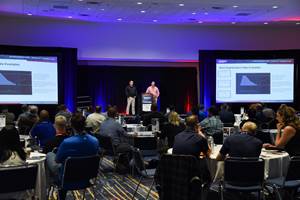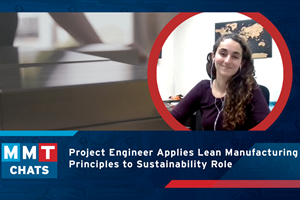Access Global Talents to Compress Leadtimes
Companies looking to be more competitive can benefit from collaboration and virtual resource amplification.
Like most manufacturing companies in today's competitive business environment, Square Deal (Elkhart, IN) - a global supplier of custom-designed, com-plex molds and dies primarily used by automotive, pharmaceutical and orthopedic companies - was looking for a way to speed up design cycles and cut product turnaround times. For a tool and die company competing with other suppliers, time-to-market is crucial, especially when working with large multi-national corporations. In order to compress times, managers at Square Deal faced a dilemma - they could add design capacity during peak demand periods, which could inflate overhead, create a burden during slower periods, negatively impact the bottom line and occasionally lead to painful layoffs. Alternatively, they could overload current resource levels with overtime, which could have a negative effect on quality, not to mention the risk of delaying projects, missing deadlines and ultimately harming their reputation for on-time delivery.
Fortunately the solution was as simple as exploiting the technologies they already had available and thinking globally.
Exploiting Technology
Virtually every manufacturing company today uses some form of CAD. When used in conjunction with the Internet and Web-based technologies, engineers can collaborate with other engineers literally any-where in the world.
Square Deal had been using collaboration software through virtual private networking (VPN) and high-speed communication links to communicate with customers and suppliers. With the collaboration software's translator utility and other CAD-neutral technologies, it was able to eliminate traditional barriers in software-specific environments and work with anyone, regardless of their CAD software. Combined with many other collaboration technologies, including Microsoft Net Meeting, Internet chat, FTP and sending screen images via e-mail, designers always had organized and immediate access to design information in real-time.
By exploiting these readily available technologies, Square Deal was able to "think outside the box" when evaluating resource levels. In addition to using these technologies to communicate with customers and suppliers, Square Deal was able to create virtual extensions of its internal design resources by thinking globally.
Going Global
In order to complement its existing design resources, Square Deal commissioned a design and development center, composed of highly trained, experienced and carefully chosen engineering graduates, operating from Techno Park, Trivandrum, India. By taking advantage of the time zone differential, it could work literally around the clock to meet virtually any deadline (see table at end of article).
In addition to increasing design capacity and dramatically cutting design cycle times, engineers were able to cut resource costs by more than 50 percent. This was due to the lower engineering rates in India, combined with the savings in overtime premiums.
By accessing global resources and exploiting technologies, Square Deal has developed a value-added business model for global collaboration (see Figure 1).
Virtual Resource Amplification
The company refers to the business model as "virtual resource amplification," because a company can amplify its resources and capacity, as an extension of its design department, without actually increasing the size of the company. The owners of Square Deal were so impressed with the benefits of virtual resources and global design collaboration that they formed a new company, Square Deal Technologies, to focus on design services and to offer its value-added model to other companies. Square Deal Technologies, headquartered in Elkhart, IN, in partnership with Square Deal Design and Engineering in India, offers design and development services to partner companies around the world. This model makes it easy for even the smallest companies to gain access to global talents.
"With our network of engineers, combined with our collaboration tools, the lo-cation of our partner companies is ir-relevant," notes Samuel Mathew, the chief operating officer at Square Deal Technologies. "With the technologies we have available, the information flow and design handoffs are seamless, whether you're in the next cubicle or halfway around the world."
Collaboration Benefits
The benefits of collaboration and virtual resources are many including:
- The ability to work around the clock to reduce leadtimes.
- Instant access to additional resources to increase capacity "on demand."
- Money savings through competitive rates, reduced overhead and reduced overtime.
- Improved designs through collaboration and "design synergy."
In addition, smaller companies that can't afford large investments in engineering and R&D can access additional resources when they need them, and only pay for what they need. Companies that are looking to become more competitive with better products, faster and cheaper can benefit from collaboration and virtual resource amplification.
| A Global Approach To Compressing Time |
| In a recent project, engineers at Square Deal Technologies were challenged to produce a prototype rubber mold for a customer that needed it in seven days. The normal time to deliver a similar mold is six to 10 weeks.
As soon as the customer data was received in Elkhart, it was analyzed and an online review with the customer and design team in India was held to ensure that the customer requirements were clear. The teams worked around the clock and around the globe so that by the end of the first day, the designs were well under way and being checked for quality. By the third day all of the designs were complete and sent to the mold shop, where the inserts were machined and electrodes were cut with EDM. During the next few days they continued to machine and polish the mold inserts. On day six the mold was set in the press, heated and tested, and on day seven the customer received good parts from the mold. The project team in Elkhart, IN, and designers in India used CAD/CAM, collaborative software and high-speed connections over a secure VPN to accomplish this task. |
Related Content
Top 10 Topics to Cover During an ISO 9001 Manufacturing Audit
Take a look at this practical hands-on approach to conducting a quality audit.
Read MoreMoldMaking Conference Session Spotlight: Data
Want to learn about digital workflows in mold design or ERP or global mold monitoring and asset management or the impact of tooling digitalization?
Read MoreFAQs: What Are the Leadtime Leader Awards?
Here are answers to some frequently asked questions about MoldMaking Technology's annual Leadtime Leader Awards competition.
Read MoreMMT Chats: Project Engineer Applies Lean Manufacturing Principles to Growing Sustainability Role
MoldMaking Technology Editorial Director Christina Fuges catches up with MMT’s 30-Under-30 Honoree Katherine Pistorius, who has added Regional Sustainability Coordinator alongside her Project Engineer duties, which demonstrates the many paths one can take in a manufacturing career. Here she shares how this opportunity unfolded for her and what the job entails today and in the future. This episode is brought to you by ISCAR with New Ideas for Machining Intelligently.
Read MoreRead Next
How to Use Strategic Planning Tools, Data to Manage the Human Side of Business
Q&A with Marion Wells, MMT EAB member and founder of Human Asset Management.
Read MoreAre You a Moldmaker Considering 3D Printing? Consider the 3D Printing Workshop at NPE2024
Presentations will cover 3D printing for mold tooling, material innovation, product development, bridge production and full-scale, high-volume additive manufacturing.
Read More

















